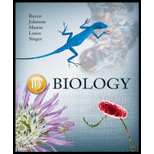
Prezygotic isolating mechanisms include all of the following except
a. hybrid sterility.
b. courtship rituals.
c. habitat separation.
d. seasonal reproduction
Introduction:
The reproductive isolation is achieved through the reproductive barriers which are the evolutionary mechanism or behaviors that prevent organism of a different species from breeding and leads to the prevention of exchange of genetic material. There are two types of reproductive barriers: Prezygotic barrier prevents the fertilization between species and postzygotic barrier prevents the maturation of hybrid zygote formed by the mating of two different species. Prezygotic barrier involves habitat, mechanical, gametic, behavioral, and temporal isolation. Postzygotic barriers involve reduced viability of the hybrid formed, reduced fertility of the hybrid and the breakdown of the hybrid that result in the sterile generations.
Answer to Problem 1U
Correct answer:
Hybrid sterility is the postzygotic barrier in which the produced hybrid formed due to the mating of two different species either does not develop properly (are sterile) or the adults do not survive for long. Therefore option a. is the correct answer.
Explanation of Solution
Reason for the correct statement:
The isolating mechanisms that prevent the formation of a zygote are known as the prezygotic isolation mechanism. It includes prevention of the fusion of gametes, ecological, behavioral, temporal, and mechanical isolation. Hybrid sterility is the postzygotic isolating mechanism in which the hybrid formed will be sterile and will not be able to reproduce.
Option a. is given as “hybrid sterility”.
As, “hybrid sterility is not a prezygotic isolating mechanism”, is the right answer.
Hence option a. is correct.
Reasons for the incorrect statements:
Option b. is given as “courtship rituals”.
The difference in courtship rituals is due to behavioral isolation which is a prezygotic isolating mechanism. So, it is a wrong answer.
Option c. is given as “habitat separation”.
Habitat separation is due to ecological isolation of species which is a prezygotic isolating mechanism. So, it is a wrong answer.
Option d. is given as “seasonal reproduction”.
Temporal isolation occurs when the species do not mate with each other due to their different reproduction seasons. It is also a prezygotic isolating mechanism. So, it is a wrong answer.
Hence options b., c., and d. are incorrect.
There are two types of reproductive isolating mechanisms: The prezygotic isolating mechanism which prevents the fertilization between species and the postzygotic isolating mechanism that prevents the maturation of hybrid zygote formed by the mating of two different species. These mechanisms are the barriers to facilitate successful reproduction and prevent the exchange of genetic material between species.
Want to see more full solutions like this?
Chapter 22 Solutions
Biology
- Outline the negative feedback loop that allows us to maintain a healthy water concentration in our blood. You may use diagram if you wisharrow_forwardGive examples of fat soluble and non-fat soluble hormonesarrow_forwardJust click view full document and register so you can see the whole document. how do i access this. following from the previous question; https://www.bartleby.com/questions-and-answers/hi-hi-with-this-unit-assessment-psy4406-tp4-report-assessment-material-case-stydu-ms-alecia-moore.-o/5e09906a-5101-4297-a8f7-49449b0bb5a7. on Google this image comes up and i have signed/ payed for the service and unable to access the full document. are you able to copy and past to this response. please see the screenshot from google page. unfortunality its not allowing me attch the image can you please show me the mathmetic calculation/ workout for the reult sectionarrow_forward
- Skryf n kortkuns van die Egyptians pyramids vertel ñ story. Maximum 500 woordearrow_forward1.)What cross will result in half homozygous dominant offspring and half heterozygous offspring? 2.) What cross will result in all heterozygous offspring?arrow_forward1.Steroids like testosterone and estrogen are nonpolar and large (~18 carbons). Steroids diffuse through membranes without transporters. Compare and contrast the remaining substances and circle the three substances that can diffuse through a membrane the fastest, without a transporter. Put a square around the other substance that can also diffuse through a membrane (1000x slower but also without a transporter). Molecule Steroid H+ CO₂ Glucose (C6H12O6) H₂O Na+ N₂ Size (Small/Big) Big Nonpolar/Polar/ Nonpolar lonizedarrow_forward
- what are the answer from the bookarrow_forwardwhat is lung cancer why plants removes liquid water intead water vapoursarrow_forward*Example 2: Tracing the path of an autosomal dominant trait Trait: Neurofibromatosis Forms of the trait: The dominant form is neurofibromatosis, caused by the production of an abnormal form of the protein neurofibromin. Affected individuals show spots of abnormal skin pigmentation and non-cancerous tumors that can interfere with the nervous system and cause blindness. Some tumors can convert to a cancerous form. i The recessive form is a normal protein - in other words, no neurofibromatosis.moovi A typical pedigree for a family that carries neurofibromatosis is shown below. Note that carriers are not indicated with half-colored shapes in this chart. Use the letter "N" to indicate the dominant neurofibromatosis allele, and the letter "n" for the normal allele. Nn nn nn 2 nn Nn A 3 N-arrow_forward
 Biology (MindTap Course List)BiologyISBN:9781337392938Author:Eldra Solomon, Charles Martin, Diana W. Martin, Linda R. BergPublisher:Cengage Learning
Biology (MindTap Course List)BiologyISBN:9781337392938Author:Eldra Solomon, Charles Martin, Diana W. Martin, Linda R. BergPublisher:Cengage Learning
 Concepts of BiologyBiologyISBN:9781938168116Author:Samantha Fowler, Rebecca Roush, James WisePublisher:OpenStax College
Concepts of BiologyBiologyISBN:9781938168116Author:Samantha Fowler, Rebecca Roush, James WisePublisher:OpenStax College Biology: The Dynamic Science (MindTap Course List)BiologyISBN:9781305389892Author:Peter J. Russell, Paul E. Hertz, Beverly McMillanPublisher:Cengage Learning
Biology: The Dynamic Science (MindTap Course List)BiologyISBN:9781305389892Author:Peter J. Russell, Paul E. Hertz, Beverly McMillanPublisher:Cengage Learning Human Heredity: Principles and Issues (MindTap Co...BiologyISBN:9781305251052Author:Michael CummingsPublisher:Cengage Learning
Human Heredity: Principles and Issues (MindTap Co...BiologyISBN:9781305251052Author:Michael CummingsPublisher:Cengage Learning Biology: The Unity and Diversity of Life (MindTap...BiologyISBN:9781305073951Author:Cecie Starr, Ralph Taggart, Christine Evers, Lisa StarrPublisher:Cengage Learning
Biology: The Unity and Diversity of Life (MindTap...BiologyISBN:9781305073951Author:Cecie Starr, Ralph Taggart, Christine Evers, Lisa StarrPublisher:Cengage Learning





